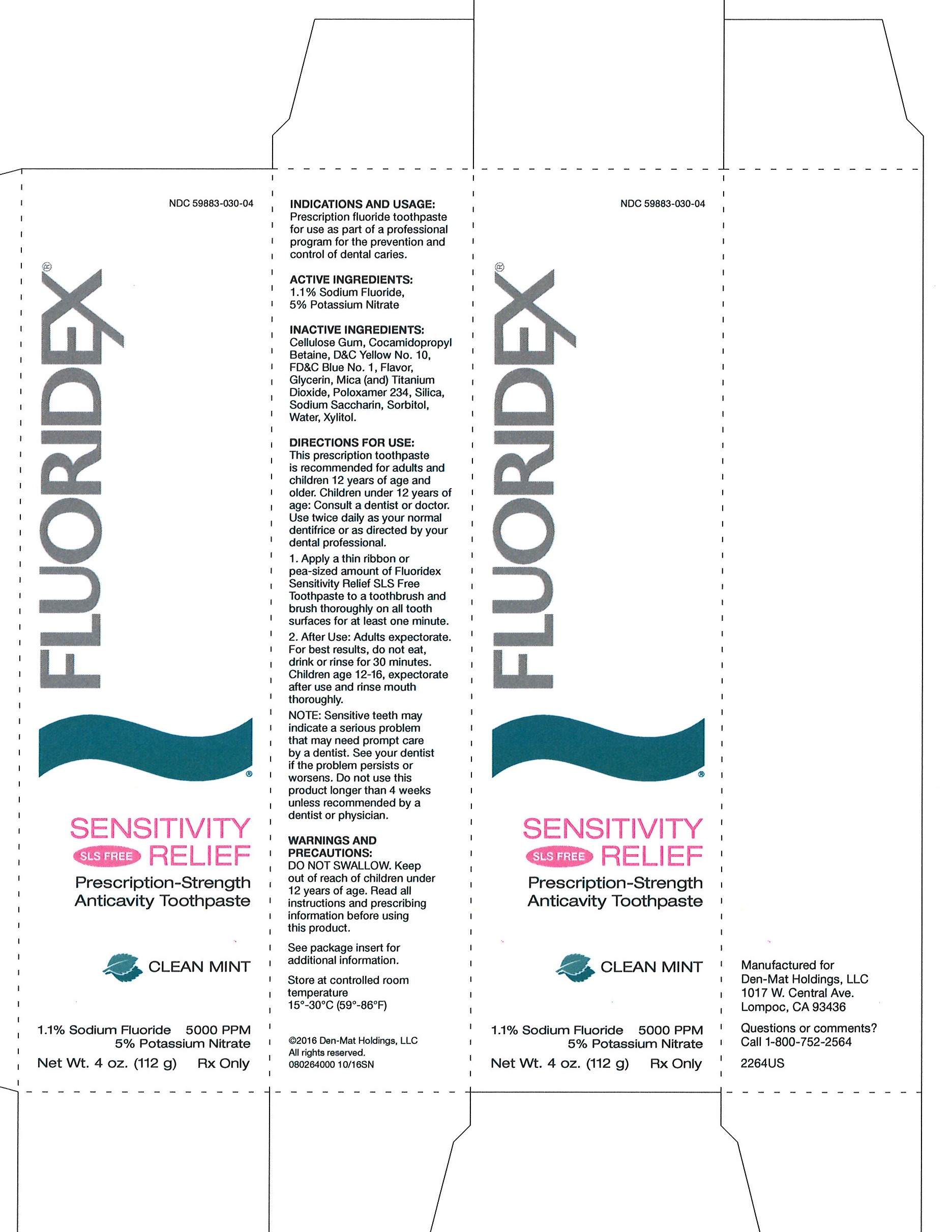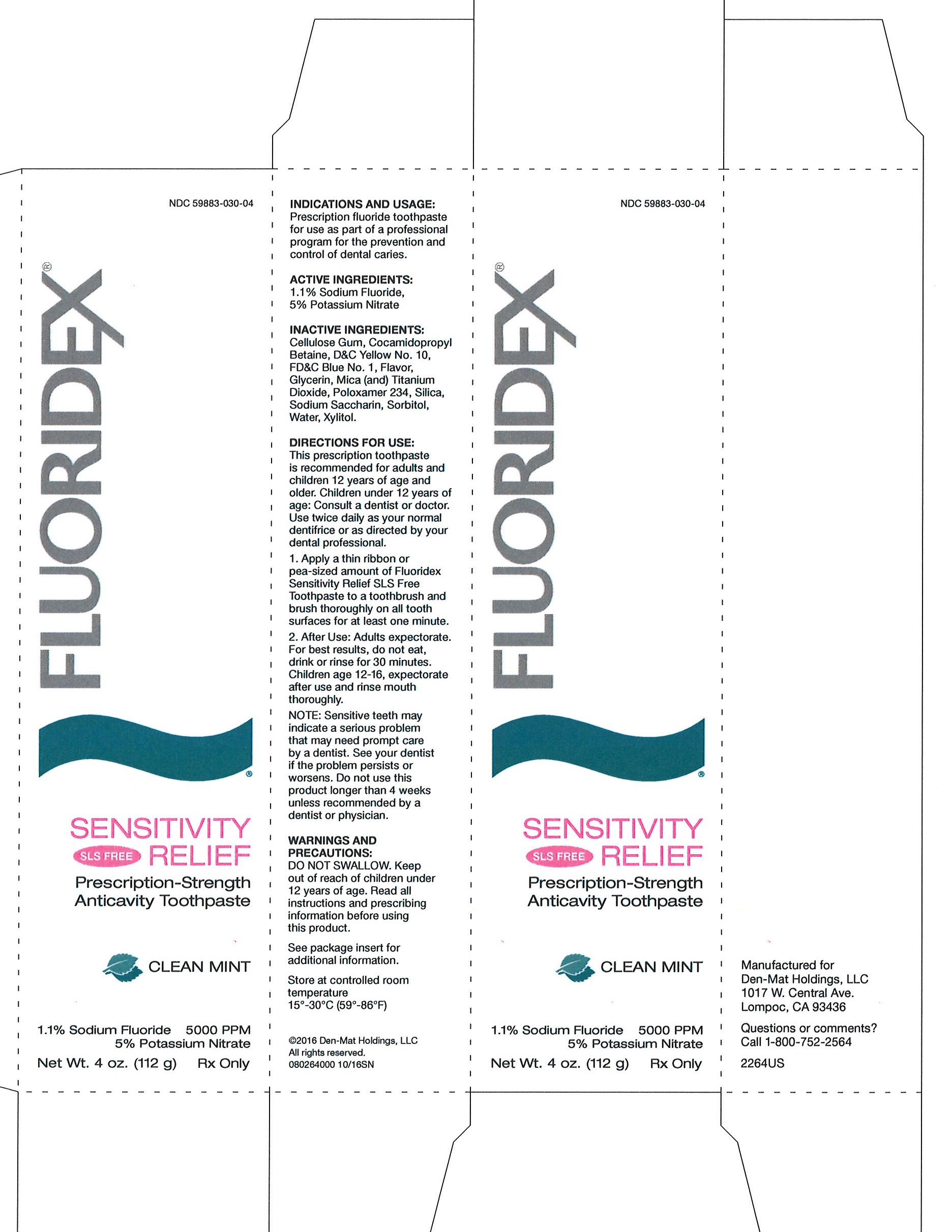Label: FLUORIDEX- sodium fluoride paste, dentifrice
- NDC Code(s): 59883-030-04
- Packager: DENT-MAT HOLDINGS, LLC.
- Category: HUMAN PRESCRIPTION DRUG LABEL
- DEA Schedule: None
- Marketing Status: unapproved drug other
DISCLAIMER: This drug has not been found by FDA to be safe and effective, and this labeling has not been approved by FDA. For further information about unapproved drugs, click here.
Drug Label Information
Updated August 3, 2023
If you are a consumer or patient please visit this version.
- Download DRUG LABEL INFO: PDF XML
- Official Label (Printer Friendly)
-
HIGHLIGHTS OF PRESCRIBING INFORMATION
HIGHLIGHTS OF PRESCRIBING INFORMATION____________________________
These highlights do not include all the information needed to use Fluoridex toothpaste safely and effectively. See full prescribing information.
Fluoridex 1.1% Sodium Fluoride, 5% Potassium Nitrate toothpaste for oral use
INDICATIONS AND USAGE_______________________________________________
Fluoridex toothpaste is indicated for use as part of a professional program for the prevention and control of dental caries. (1)
DOSAGE AND ADMINISTRATION_________________________________________
• Apply a thin ribbon or pea-sized amount of Fluoridex toothpaste to a toothbrush and brush thoroughly on all tooth surfaces for at least one minute. (2)
• After use, adults should expectorate. For best results, do not eat, drink, or rinse for 30 minutes. Children, age 12-16, should expectorate after use and rinse mouth thoroughly. (2)
• Children under 12 years of age should consult a dentist or doctor.
• Use twice daily as your normal dentifrice or as directed by your dental professional. (2)
DOSAGE FORMS AND STRENGTHS______________________________________
• Sensitivity Relief: Green toothpaste containing 1.1% Sodium Fluoride, 5% Potassium Nitrate (Mint). (3)
• Sensitivity Relief SLS Free: Green toothpaste containing 1.1% Sodium Fluoride, 5% Potassium Nitrate (Mint). (3)
CONTRAINDICATIONS___________________________________________________
Do not use in children under 6 years of age unless recommended by a dentist or physician. (4)
WARNINGS AND PRECAUTIONS_________________________________________
● DO NOT SWALLOW. (5)
● Keep out of reach of children under 12 years of age. If more than used for brushing is accidentally swallowed, get medical help or contact a Poison Control Center right away. (5)
● Repeated ingestion of high levels of fluoride may cause dental fluorosis. (5)
● Do not use this product longer than 4 weeks unless recommended by a dentist or physician. (5)
ADVERSE REACTIONS___________________________________________________
Allergic reactions and other idiosyncrasies have been rarely reported. (6)
To report SUSPECTED ADVERSE REACTIONS, contact DenMat, at 1-800-752-2564, or FDA at 1-800-FDA-1088 or www.fda.gov/medwatch
- 1 INDICATIONS AND USAGE
-
2 DOSAGE AND ADMINISTRATION
• Follow these instructions or use as instructed by a dental professional.• Adults and children age 6 or older, apply a thin ribbon or pea-sized amount of Fluoridex toothpaste to a toothbrush and brush thoroughly on all tooth surfaces for at least one minute.
After use:
• Adults should expectorate. For best results, do not eat, drink, or rinse for 30 minutes.
• Children, age 6 to 16, should expectorate after use and rinse mouth thoroughly.
• Use twice daily as your normal dentifrice or as directed by your dental professional.
- 3 DOSAGE FORMS AND STRENGTHS
- 4 CONTRAINDICATIONS
-
5 WARNINGS AND PRECAUTIONS
DO NOT SWALLOW.
• Keep out of reach of children under 12 years of age. If more than used for brushing is accidentally swallowed, get medical help or contact a Poison Control Center right away.
• Prolonged daily ingestion may result in various degrees of dental fluorosis in children with developing dentition, especially if the water fluoridation exceeds 0.6 ppm, since younger children frequently cannot perform the brushing process without significant swallowing.
• Use in children under age 6 years requires special supervision to prevent repeated swallowing of toothpaste which could cause dental fluorosis.
• Read directions carefully before using.
• Keep out of reach of infants and children.
• Sensitive teeth may indicate a serious problem that may need prompt care by a dentist.
• See your dentist if the problem persists or worsens. Do not use this product longer than 4 weeks unless recommended by a dentist or physician.
- 6 ADVERSE REACTIONS
-
8 USE IN SPECIFIC POPULATIONS
8.1 Pregnancy
Pregnancy Category B It has been shown that fluoride crosses the placenta of rats, but only 0.01% of the amount administered is incorporated in fetal tissues. Animal studies (rats, mice, rabbits) have shown that fluoride is not a teratogen. Maternal exposure to 12.2 mg fluoride/kg of body weight (rats) or 13.1 mg/kg of body weight (rabbits) did not affect the litter size or fetal weight and did not increase the frequency of skeletal or visceral malformations. There are no adequate or well controlled clinical studies in pregnant women. However, epidemiological studies conducted in areas with high levels of naturally fluoridated water showed no increase in birth defects. Heavy exposure to fluoride during in utero development may result in skeletal fluorosis which becomes evident in childhood.
8.3 Nursing Mothers
It is not known if fluoride is excreted in human milk. However, many drugs are excreted in milk, and caution should be exercised when products containing fluoride are administered to a nursing woman. Reduced milk production was reported in farm-raised fox when the animals were fed a diet containing a high concentration of fluoride (98-137 mg/kg of body weight). No adverse effects on parturition, lactation, or offspring were seen in rats administered fluoride up to 5 mg/kg of body weight.
8.4 Pediatric Use
The use of Fluoridex toothpaste in children age 6-16 as a caries preventive is supported by pioneering clinical studies with 1.1% sodium fluoride gels in mouth trays in students age 11-14 years conducted by Englander, et al.2-4 Safety and effectiveness in pediatric patients below the age of 6 years have not been established. Prescribing physicians and dentists should consider total fluoride exposure (dental care plus food, water, and other sources) when prescribing the product for use in children. Please refer to the CONTRAINDICATIONS and WARNINGS AND PRECAUTIONS sections.
8.5 Geriatric Use
Subjects referenced in clinical studies of 1.1% (w/v) sodium fluoride, included 15 percent age 65 and over, with 1 percent age 75 and over. No overall differences in safety or effectiveness were observed between these subjects and younger subjects. Other reported clinical experience has not identified differences in responses between the elderly and younger clients, but greater sensitivity of some older individuals cannot be ruled out. This drug is known to be substantially excreted by the kidney, and the risk of toxic reactions to this drug may be greater in clients with impaired renal function. Because elderly clients are more likely to have decreased renal function, care should be taken in dose selection, and it may be useful to monitor renal function.
-
10 OVERDOSAGE
Accidental ingestion of large amounts of fluoride may result in acute burning in the mouth and sore tongue. Nausea, vomiting, and diarrhea may occur soon after ingestion (within 30 minutes) and are accompanied by salivation, hematemesis, and epigastric cramping abdominal pain. These symptoms may persist for 24 hours. If less than 5 mg fluoride/kg body weight (i.e., less than 2.3 mg fluoride/lb body weight) have been ingested, give calcium (e.g., milk) orally to relieve gastrointestinal symptoms and observe for a few hours. If more than 5 mg fluoride/kg body weight (i.e., more than 2.3 mg fluoride/lb body weight) have been ingested, induce vomiting, give orally soluble calcium (e.g., milk, 5% calcium gluconate or calcium lactate solution) and immediately seek medical assistance. For accidental ingestion of more than 15 mg fluoride/kg of body weight (i.e., more than 6.9 mg fluoride/lb body weight), induce vomiting and admit immediately to a hospital facility.
-
11 DESCRIPTION
Fluoridex toothpaste is a self-applied topical fluoride dentifrice containing 1.1% (w/w) sodium fluoride for the prevention and control of dental caries, and 5% (w/w) Potassium Nitrate for relief of tooth sensitivity.
Sensitivity Relief:Each gram contains 5 mg of fluoride ion in a neutral pH base, consisting of Cellulose Gum, D&C Yellow No. 10, FD&C Blue No. 1, Flavor, Glycerin, Mica (and) Titanium Dioxide, Poloxamer 234, Potassium Nitrate, Silica, Sodium Lauryl Sulfate, Sodium Saccharin, Sorbitol, Water, Xylitol.
Sensitivity Relief SLS Free: Each gram contains 5 mg of fluoride ion in a neutral pH base, consisting of Cellulose Gum, Cocamidopropyl Betaine, D&C Yellow No. 10, FD&C Blue No. 1, Flavor, Glycerin, Mica (and) Titanium Dioxide, Poloxamer 234, Potassium Nitrate, Silica, Sodium Saccharin, Sorbitol, Water, Xylitol.
-
12 CLINICAL PHARMACOLOGY
A treatment dose (a thin ribbon) of Fluoridex 5000 ppm sodium fluoride toothpaste contains 2.5 mg fluoride. A 4 oz. tube contains 566 mg fluoride.
Frequent topical applications to the teeth with preparations having a relatively high fluoride content increase tooth resistance to acid dissolution and enhance penetration of the fluoride ion into tooth enamel.
-
13 NONCLINICAL TOXICOLOGY
13.1 Carcinogenesis, Mutagenesis, Impairment of Fertility
In a study conducted in rodents, no carcinogenesis was found in male and female mice and female rats treated with fluoride at dose levels ranging from 4.1 to 9.1 mg/kg of body weight. Equivocal evidence of carcinogenesis was reported in male rats treated with 2.5 and 4.1 mg/kg of body weight. In a second study, no carcinogenesis was observed in rats, males or females, treated with fluoride up to 11.3 mg/kg of body weight. Epidemiological data provide no credible evidence for an association between fluoride, either naturally occurring or added to drinking water, and risk of human cancer. Fluoride ion is not mutagenic in standard bacterial systems. It has been shown that fluoride ion has potential to induce chromosome aberrations in cultured human and rodent cells at doses much higher than those to which humans are exposed. In vivo data are conflicting. Some studies report chromosome damage in rodents, while other studies using similar protocols report negative results. Potential adverse reproductive effects of fluoride exposure in humans have not been adequately evaluated. Adverse effects on reproduction were reported for rats, mice, fox, and cattle exposed to 100 ppm or greater concentrations of fluoride in their diet or drinking water. Other studies conducted in rats demonstrated that lower concentrations of fluoride (5 mg/kg of body weight) did not result in impaired fertility and reproductive capabilities.
-
15 REFERENCES
1. American Dental Association, Council on Dental Therapeutics, Fluoride compounds, In: Accepted Dental Therapeutics, Ed. 40, Chicago, ADA, 405-407, (1984).
2. Englander HR, et al., Clinical Anticaries Effect of Repeated Topical Sodium Fluroide Applications by Mouthpieces, JADA, 75, 638-644, (1967).
3. Englander HR, et al., Residual Anticaries Effect of Repeated Topical Sodium Fluoride Applications by Mouthpieces, JADA, 78, 783-787 (1969).
4. Englander HR, et al: JADA, 83:354-358, 1971.
- 16 HOW SUPPLIED/STORAGE AND HANDLING
- Principal Display Panel
-
INGREDIENTS AND APPEARANCE
FLUORIDEX
sodium fluoride paste, dentifriceProduct Information Product Type HUMAN PRESCRIPTION DRUG Item Code (Source) NDC:59883-030 Route of Administration DENTAL Active Ingredient/Active Moiety Ingredient Name Basis of Strength Strength SODIUM FLUORIDE (UNII: 8ZYQ1474W7) (FLUORIDE ION - UNII:Q80VPU408O) FLUORIDE ION 5 mg in 1 g POTASSIUM NITRATE (UNII: RU45X2JN0Z) (NITRATE ION - UNII:T93E9Y2844) POTASSIUM NITRATE 50 mg in 1 g Inactive Ingredients Ingredient Name Strength COCAMIDOPROPYL BETAINE (UNII: 5OCF3O11KX) MINT (UNII: FV98Z8GITP) Product Characteristics Color green Score Shape Size Flavor MINT (Clean Mint) Imprint Code Contains Packaging # Item Code Package Description Marketing Start Date Marketing End Date 1 NDC:59883-030-04 1 in 1 BOX 01/06/2017 1 112 g in 1 TUBE; Type 0: Not a Combination Product Marketing Information Marketing Category Application Number or Monograph Citation Marketing Start Date Marketing End Date unapproved drug other 01/06/2017 Labeler - DENT-MAT HOLDINGS, LLC. (809857704)


